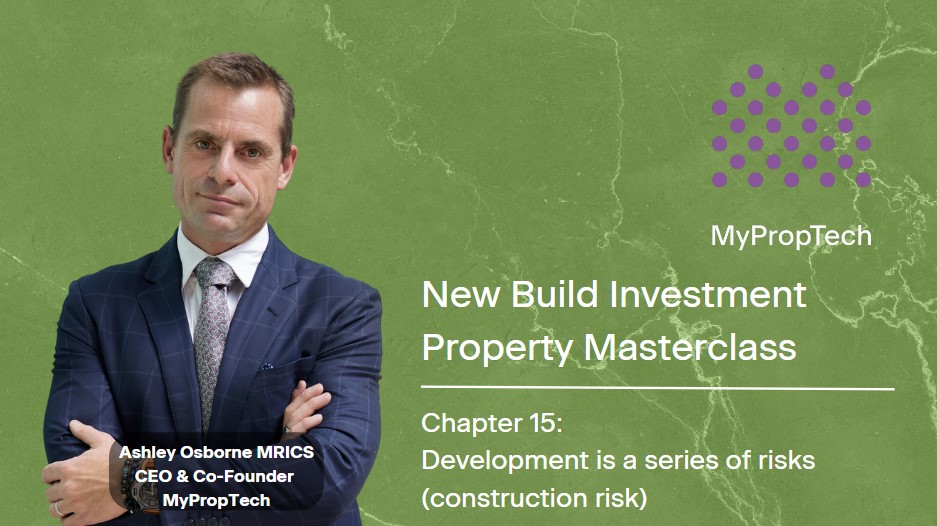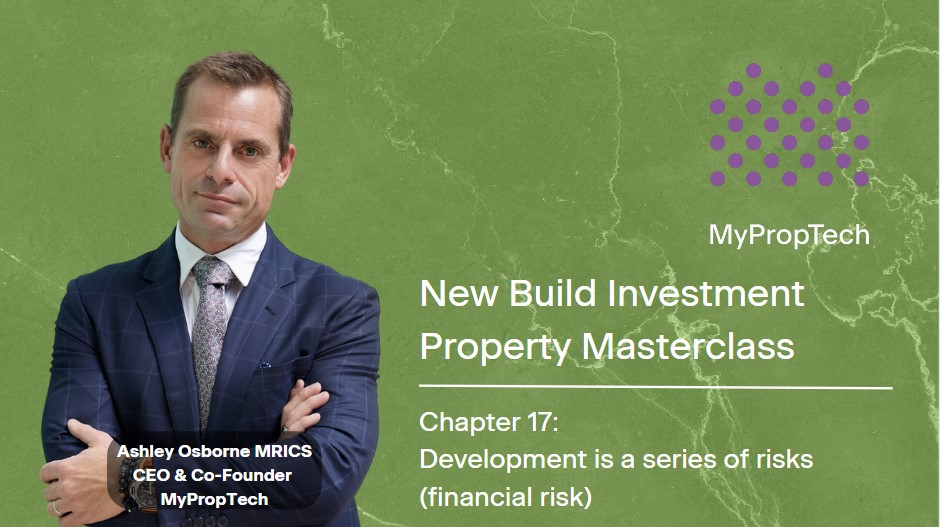New Build Investment Property Masterclass: Chapter 13 - Development is a series of risks (land risk)
Development is a series of risks
Development is a series of risks. The developer manages these risks to deliver the development profit.
The developer's development profit is the 'GDV' less the cost of the risks associated with developing and selling the development. Think of it like this:
Gross Development Value, less
- Land risk: Cost of buying the land
- Planning risk: Cost of obtaining consent
- Construction risk: Cost of any demolition works and building a new building
- Sales risk: Cost of marketing and selling the development
- Finance risk: Cost of the capital employed for the development
= Development Profit
Land risk
Buying land for development incorporates several elements which need to be considered and managed.
Existing landowners
Land which is likely to be developed for residential use is generally held by companies or individuals for specific purposes, and many of these are not residential uses. When negotiating to purchase land, developers need to consider the needs of the existing owners.
Alternative locations
Many landowners use their land for the operation of a commercial enterprise. If they sell their land and plan to continue trading, they will have to find an alternative location. Often, a developer will have to assist the owner to find an alternative location to relocate to.
Major asset
For many landowners, the land is one of their largest assets. Understandably, they want to ensure that they are maximising its value when they come to sell it. Many owners watch several market cycles before they sell their land to a developer, so that they can be confident they are getting the best possible deal.
Many developers and agents track land sites for many years, staying in regular contact with the landowner to maintain a relationship with them. They do this to be there at exactly the right time when the landowner decides to sell.
Site assembly
Many parcels of land are small, and do not easily lend themselves to residential development on their own. In this scenario, a developer will need to undertake what is referred to as a 'land assembly' by linking two or more parcels of land together to create a greater density of development from one larger parcel of land.
Planning status
Land can be purchased with three specific different types of planning status:
- A site not allocated for residential development;
- A site without specific planning consent;
- A site with specific planning consent.
From a development perspective, there is a risk attached to taking a site through the residential planning process. Just because a developer wishes to develop a certain type of building on a parcel of land, it does not necessarily follow that the local planning authority will grant that application.
Planning authorities and residents may typically respond negatively to a development because of the following arguments:
- It causes disruption.
- It changes the local area.
- New residents moving to a location will have an impact.
- Additional stress and strain will be put on the local infrastructure. In many cities and countries, the public infrastructure is already under tremendous strain.
Site risk
Most developers will tell you that most of the risk associated with development is under the surface of the ground. This is because it is difficult to know what is below the surface until they start digging (groundworks). Some of the issues which may arise from groundworks are:
- Site contamination: The land is contaminated, and remedial works are required before construction can take place. In many situations, the extent of the remedial works will not be known, and until this is known it is difficult to determine what the cost will be.
- Soil substructure: The load-bearing capacity of the soil will be a major factor in the depth of piling, foundations, and works required for basements, all of which will have a significant impact on the cost of construction. Whilst it is possible for a developer to undertake soil tests, it is virtually impossible for them to effectively cover the whole site.
- Archaeological issues: It is not uncommon for groundworks to uncover various archaeological issues. Dealing with these issues in the soil can add both significant time and cost to construction projects.
Market competition
Competition is another consideration and thus another form of risk for developers. Land is a scarce resource, so when parcels of land are available for sale which lend themselves to residential development, competition from other developers is highly likely.
It is not uncommon for developers to find themselves in a bidding war with other developers to purchase land. Developers can purchase land via various methods, including:
- Unconditional purchase: Simply buying the property outright and accepting all the risk associated with the land;
- Option: Agreeing an option to purchase the land subject to several things happening, the most common being obtaining a planning consent or undertaking a land assembly;
- Subject to planning: Agreeing to purchase a site subject to obtaining a planning consent; or
- Purchasing with planning consent: Purchasing a site with an existing planning consent which has been achieved by the landowner.
There are costs associated with bidding on a parcel of land, and a significant amount of work is required in bidding to purchase a site. Developers typically need to go through several rounds of bidding and interviews to purchase land. It may therefore take several months to go through the bidding process.
In determining to bid on a development site, developers need to consider how much work will be required to formulate a bid, and estimate the likelihood of being successful. In undertaking this work, the developer will undertake a residual land value calculation, which involves determining what they believe they can build on the land, and the collective sale price of its components. This is referred to as its Gross Development Value (GDV), and they will then make their best estimates of the following:
- Cost to get planning permission
- Cost to demolish any existing improvements
- Cost to build a new building
- Cost to market and sell
- Cost of finance
- Their expected profit from the development
The net result will be the Residual Land Value, which is therefore how much the developer can pay for a site – assuming their assumptions are correct. The lower they pay for the land, the more profit they will make (all other things being equal), and likewise the more they pay for the land above the residual value, the lower their profit will be.
There is a significant risk for developers that if miscalculate the sales prices for different parts of the development or the costs involved in the development, they could pay far too much for the land. If this happens, the development may generate a loss rather than a profit.
 By
By

